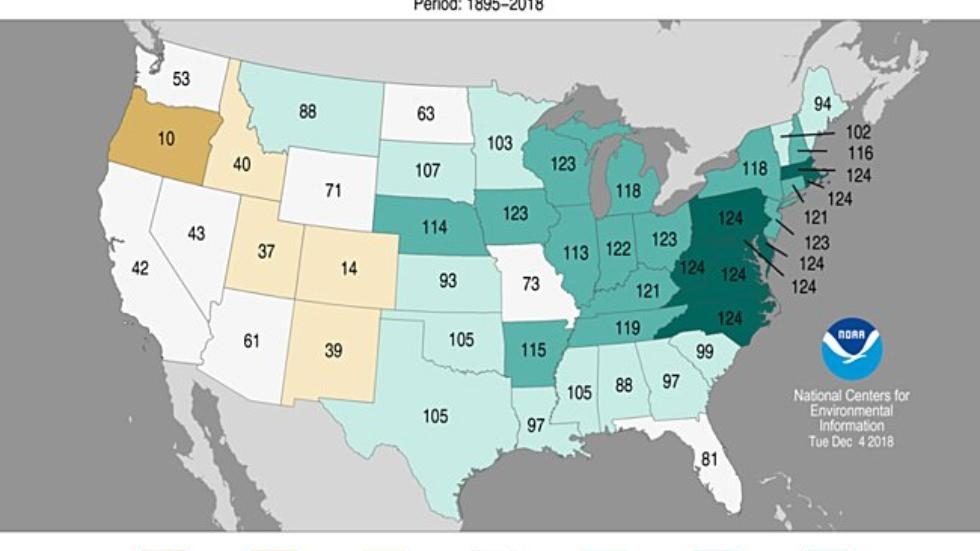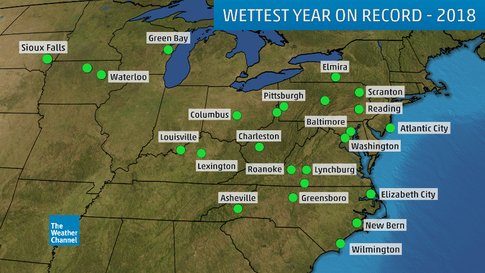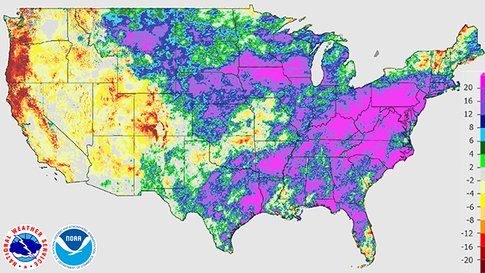
On Dec. 15, Reagan National Airport's year-to-date precipitation total eclipsed the previous record-wet year in the nation's capital, which had stood for 129 years, since Benjamin Harrison took office as president.
After topping the record, they would tack on almost 5 inches of additional rain in the latter half of December.
Washington D.C. set a record-wet November, fifth-wettest September, fourth-wettest July and sixth-wettest May, according to National Weather Service records dating to 1871. Only January, March and October were drier than average in 2018 in the nation's capital.

Record wettest calendar year on record set in Washington @Reagan_Airport pic.twitter.com/S9e4vyeJ24
— NWS DC/Baltimore (@NWS_BaltWash) December 15, 2018
As impressive as that record is, Baltimore's BWI Airport topped its previous record-wet year - 62.66 inches in 2003 - in mid-November and crushed that record by over 9 inches.
For the first time, over 60 inches of precipitation was measured in a year on the Penn State University campus.
Not surprisingly, the Mid-Atlantic states saw a record number of flood events in 2018, pointed out by the National Weather Service Middle Atlantic River Forecast Center.
Exhausted yet? The 33 #floods in 2018 has rocketed past the previous record of only 24 floods back in 2003. The average is about 12 per year.
— NWS MARFC (@NWSMARFC) December 19, 2018
And flood 34 seems to be on our doorstep. pic.twitter.com/Jox1bk3Bvf
Other yearly precipitation records were set in Pittsburgh (57.83 inches), Charleston, West Virginia (67.05 inches), Louisville, Kentucky (68.83 inches), and Columbus, Ohio (55.18 inches).
Lynchburg, Virginia, easily surpassed its previous record-wet year in 1972, which included Hurricane Agnes, a prolific eastern U.S. flood-producer.
Wilmington, North Carolina, crushed its previous record-wet year during Hurricane Florence in mid-September. On Dec. 15, the city reached 100 inches of yearly precipitation for the first time in records dating to 1871.
We made it! pic.twitter.com/FxvfECtVmp
— NWS Wilmington NC (@NWSWilmingtonNC) December 15, 2018
Even taking away Florence's rainfall, Wilmington would have had its second-wettest year.
Perhaps more staggering, an all-time state yearly rain record appears to have fallen in South Carolina.
According to the National Weather Service, 123.45 inches of precipitation was recorded at the Walhalla State Fish Hatchery west-northwest of the town of Jocassee, South Carolina, in 2018.
If the measurement is accepted after further review by the State Climate Extremes Committee, it would be the heaviest yearly precipitation total on record for any location in South Carolina.
Yearly precipitation surpluses of at least a foot cover rather staggering swaths of the East, South and Midwest.

Wilmington, North Carolina: 44.79-inch surplus
Williamsport, Pennsylvania: 28.74-inch surplus
Beaumont/Port Arthur, Texas: 28.28-inch surplus
Louisville, Kentucky: 23.92-inch surplus
Athens, Georgia: 22.93-inch surplus
Eight states in the East - Delaware, Maryland, Massachusetts, North Carolina, Pennsylvania, Rhode Island, Virginia and West Virginia - had the wettest first 11 months of any year in records dating to 1895, according to NOAA's November U.S. climate report.
NOAA's complete 2018 U.S. report is expected to be issued during the second week of January.
Rainfall from Hurricane Florence in mid-September, one of the nation's heaviest rain events on record, played a significant role in these whopping 2018 totals in parts of the Carolinas.
A number of heavy rain events - including in Ellicott City, Maryland, in late May and in Pennsylvania's lower Susquehanna Valley in late July - contributed to a waterlogged 2018 in the mid-Atlantic states.



Comment: See also: Record rainfall was the story of 2018 weather in West Virginia